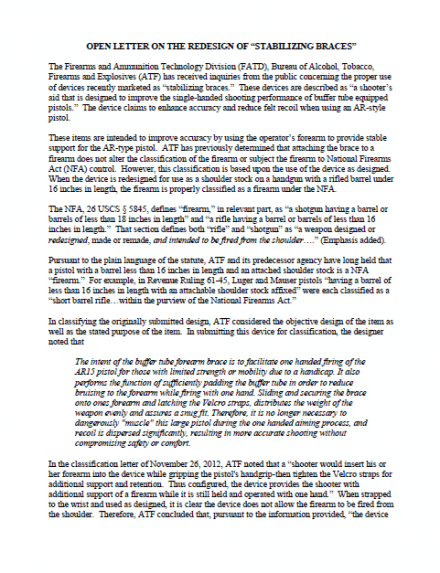The BATFE has struck! Several years ago, SIG SAUER introduced the SB-15, a shooting brace that attached to a pistol order to assist the shooters in wielding rifle caliber pistols one-handed.
According to the ATF, “These devices are described as “a shooter’s aid that is designed to improve the single-handed shooting performance of buffer tube equipped pistols.” The device claims to enhance accuracy and reduce felt recoil when using an AR-style pistol.” Of course, we all know that people have been using them to shoulder rifle caliber pistols. The problem is, some of those very people kept writing the ATF and asking about the legality of using them this way.
Thanks to all those inquiries from concerned citizens, on 16 January, 2016, just three days before SHOT Show, the Firearms and Ammunition Technology Division (FATD), Bureau of Alcohol, Tobacco, Firearms and Explosives (ATF) has issued a “OPEN LETTER ON THE REDESIGN OF “STABILIZING BRACES”.
(Insert golf clap and the phrase, “This is why we can’t have nice things.)
Here are a few pertinent highlights:
ATF hereby confirms that if used as designed—to assist shooters in stabilizing a handgun while shooting with a single hand—the device is not considered a shoulder stock and therefore may be attached to a handgun without making a NFA firearm. However, ATF has received numerous inquiries regarding alternate uses for this device, including use as a shoulder stock. Because the NFA defines both rifle and shotgun to include any “weapon designed or redesigned, made or remade, and intended to be fired from the shoulder,” any person who redesigns a stabilizing brace for use as a shoulder stock makes a NFA firearm when attached to a pistol with a rifled barrel under 16 inches in length or a handgun with a smooth bore under 18 inches in length.
The pistol stabilizing brace was neither “designed” nor approved to be used as a shoulder stock, and therefore use as a shoulder stock constitutes a “redesign” of the device because a possessor has changed the very function of the item. Any individual letters stating otherwise are contrary to the plain language of the NFA, misapply Federal law, and are hereby revoked. (emphasis added)
Any person who intends to use a handgun stabilizing brace as a shoulder stock on a pistol (having a rifled barrel under 16 inches in length or a smooth bore firearm with a barrel under 18 inches in length) must first file an ATF Form 1 and pay the applicable tax because the resulting firearm will be subject to all provisions of the NFA.
The letter is pretty straight forward. It doesn’t make the Stabilizing Brace illegal as designed. It doesn’t even make it illegal to use as a stock on a pistol (ahem, rifle) with a barrel under 16″ or a shottie under 18″. But if you do, you’ll need to submit a Form 1 and get a tax stamp to create a short barreled rifle or shotgun.
There’s a takeaway here, but what’s the point of even kicking the horse? It’s dead.
(h/t Recoil – Gear Scout)


















































































































